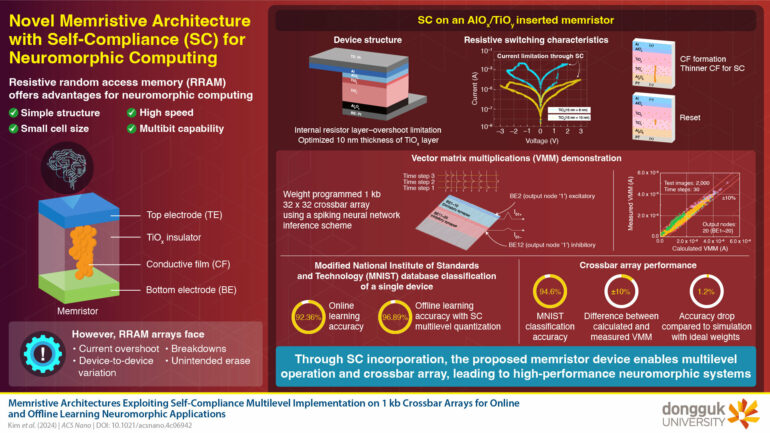In recent years, artificial intelligence (AI) and the Internet of Things have progressed rapidly, driving advancements in areas like speech recognition, image classification in autonomous vehicles, and large language models like ChatGPT. A key element in AI is deep learning, which requires parallel processing of large amounts of data—an area where traditional computers still struggle with efficiency. Neuromorphic or brain-like computing systems, consisting of artificial neurons and synapses, offer low power consumption and efficient data processing.
One of the most promising semiconductor technologies for neuromorphic computing is the resistive random-access memory (RRAM), a type of memristive device. Memristive devices have the unique ability to “remember” past electrical states. In RRAM, this memory effect arises from the formation and dissolution of a conductive filament (CF) in the insulator layer of its metal-insulator-metal structure. Metal oxide insulators play an essential role in this process.
However, while titanium-oxide-based RRAMs offer several advantages, they suffer from device-to-device variations, caused by overshoot currents during CF formation. This can lead to breakdowns or unintended memory erasure. Current methods to mitigate overshoot currents require the addition of transistors or external current compliance (CC) settings, increasing complexity.
In a breakthrough, a research team from South Korea, led by Professor Sungjun Kim from the Division of Electronics and Electrical Engineering at Dongguk University, has developed a self-compliant (SC) memristor device that overcomes these issues.
Prof. Kim says, “In this study, we achieved SC on a high-density two-terminal memristor and implemented vector-matrix multiplication (VMM), the core of AI semiconductor computation, on a 32 x 32 memristor array.” The study appears in ACS Nano.
The innovative memristor device has an aluminum oxide/titanium-oxide (AlOx/TiOy) layer on top of the insulator layer. This layer acts as an internal resistor, preventing overshoot currents by controlling the thickness of the CF formed during switching, which achieves SC. The researchers fine-tuned the TiOy layer to 10 nanometers, improving the device’s performance.
Through a series of experiments, the researchers demonstrated the device’s consistent switching characteristics without external CC and reliable multilevel operation with low power consumption. They also studied the device’s long-term potentiation (LTP) and long-term depression (LTD) characteristics, which represent the strength of synaptic connections between neurons in neuromorphic computing systems.
Using these characteristics, they simulated neural networks based on the device to classify images from the well-known MNIST database. Results revealed an online learning accuracy of 92.36%. Furthermore, offline learning neural networks that leveraged the device’s SC multilevel mode achieved an accuracy of 96.89%.
Ultimately, the researchers built a neural network using a 32 x 32 crossbar array of their memristors to demonstrate spiking neural network (SNN)-based VMM operations. SNNs, which mimic the computation processes of the brain, are known for their low power consumption. The crossbar array-based neural network achieved a 94.6% classification accuracy on the MNIST dataset, with only a 1.2% accuracy drop compared to simulation results, which shows its exceptional capabilities.
“Memristor arrays will be pivotal in next-generation computing architectures due to their speed, efficiency, and scalability,” remarks Prof. Kim. “Beyond neuromorphic computing, they have a wide range of potential applications, including non-volatile memory, IoT, machine learning, and cryptography. Furthermore, neural processing units–specialized for AI operations–require memory chips tailored for VMM operations, such as the high yield memristor array developed in this study.”
In summary, this innovative device opens avenues for the development of high-performance, energy-efficient neuromorphic computing systems, unlocking advanced new AI applications.
More information:
Sungjoon Kim et al, Memristive Architectures Exploiting Self-Compliance Multilevel Implementation on 1 kb Crossbar Arrays for Online and Offline Learning Neuromorphic Applications, ACS Nano (2024). DOI: 10.1021/acsnano.4c06942
Provided by
Dongguk University Evaluation and Audit Team
Citation:
Self-compliant memristive device enables multilevel operation and crossbar array for forming neural networks (2024, October 23)



